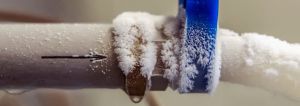
Granted, Benjamin Franklin had fire safety in mind when, in 1736, he famously advised Philadelphians that “An ounce of prevention is worth a pound of cure.” But his words could just as easily apply to keeping your home safe from freezing pipes.
And for anyone living in an area where temperatures regularly dip below freezing (which is most of the country this year; thank you, Polar Vortex), a few precautionary steps to protect your plumbing can be a cost-effective way to avoid cleaning up after a burst pipe. Consider that the Insurance Institute for Business and Home Safety (IBHS) says one frozen pipe that bursts can result in more than $5,000 worth of water-related damages.
Read on to find out what the IBHS says you can do to stay ahead of the freeze.
Protect Pipes Before a Freeze
Be sure to insulate all accessible pipes well before a cold snap. If you’re not sure what type of pipe insulation to use, ask your local hardware store. The pros there will be familiar with the kind of winter temperatures you’re facing.
Look for water pipes in unheated areas of your home (like the garage) or areas where pipes might be set next to an exterior wall (like the cabinets under kitchen or bathroom sinks), and apply pipe insulation.
Shore up all cracks and holes you find on your home’s outside walls (a task for next spring if you haven’t already done it; caulk typically needs to be applied in temperatures of at least 40 degrees). Use only a sealant or caulk approved for exterior use.
Take Action When Temperatures Drop
Regularly listen to your daily weather report, and be prepared for freezing temperatures and other winter advisories.(or get a weather app for your smartphone)
During severe cold snaps, keep exterior doors to unheated spaces, such as garages, closed.
If kitchen or bathroom pipes are located near exterior walls, leave the cabinet doors open or use a fan to circulate the warmer air around the pipes.
Although it doesn’t conserve water, let all taps slowly drip during extreme cold snaps to prevent water from freezing and to relieve pressure in the event that some water does freeze.
Consider installing a water leak alarm in areas where you might expect a problem, such as the basement; the alarm sounds when water is detected and can quickly alert you to a problem.
How to Check for Frozen Pipes (And Thaw Them)
To check on your pipes, IBHS suggests turning on each faucet (both hot and cold). If there’s only a trickle of water or, even worse, there’s no water coming out at all, then you should suspect a frozen pipe. The source of the freeze is most likely near an exterior wall or where the main water supply enters your home, says IBHS, so leave the faucet on and use a blow dryer (never an open flame torch or other device) to heat the pipe until there’s a steady flow of water.
Of course, if you can’t locate the frozen pipe or just aren’t comfortable doing it yourself, call a licensed plumber, who may also have advice (like relocating certain pipes) to prevent a similar freeze in the future.
This article originally appeared on The Allstate Blog.
















